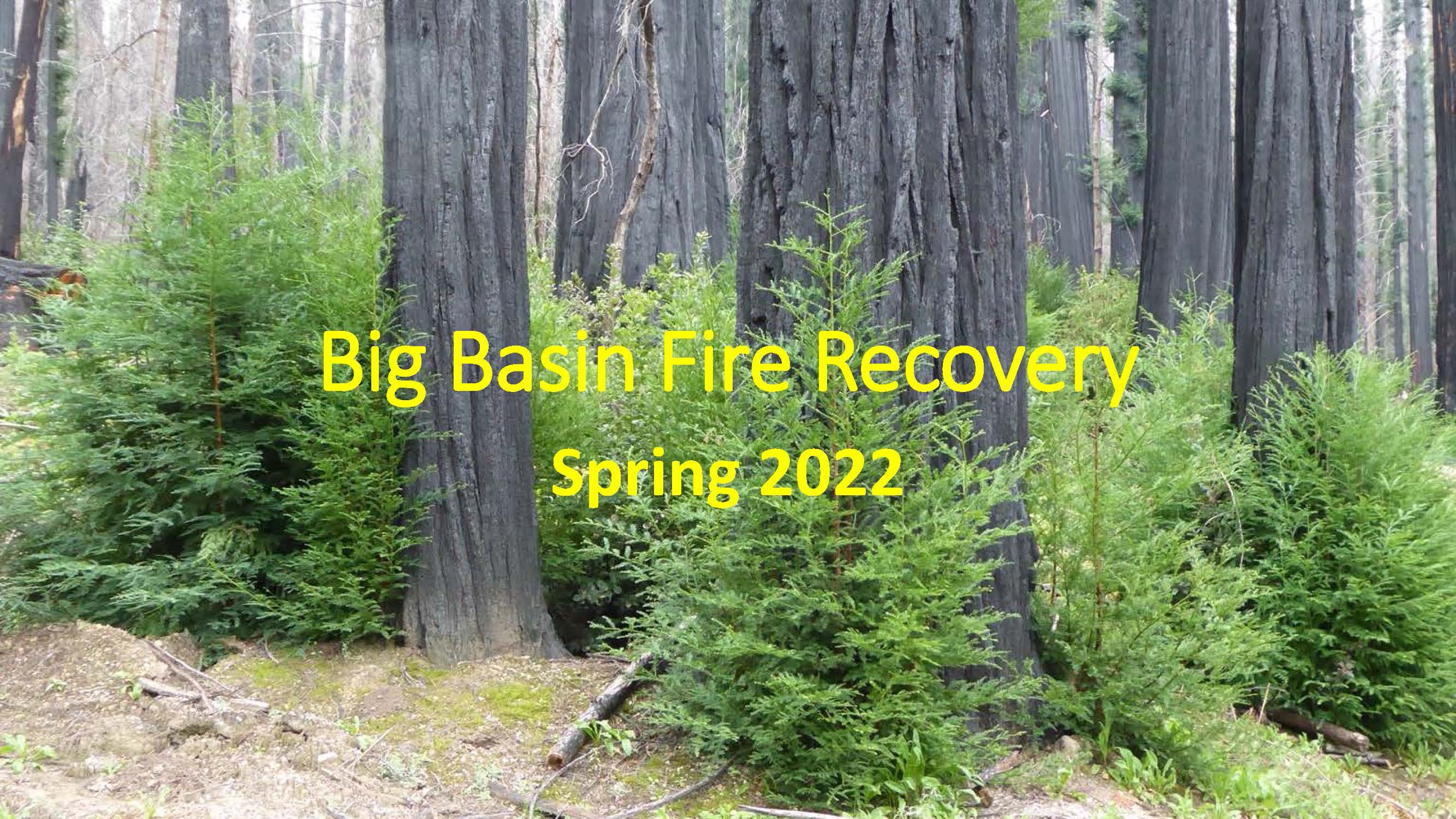Big Basin Fire Recovery—April 2022
Big Basin’s Second Spring After the Fire Reveals Major Changes to the Forest Landscape — observations by Steve Singer, Biologist
Important Note: The park remains closed to the public. I have been granted limited access to conduct an on-going research project.
I returned to Big Basin in late March after a six-month absence. My first 2022 visit was on a cool, heavily overcast and windy day. The trees were still actively responding to the fire, no longer smoldering, but many were active by dropping dead branches – branches as large as the diameter of your arm. I was glad to be wearing my hard hat. It was surprising that so much material was still falling from the trees, even two years after the fire. Over the winter, a number of fire-weakened trees had fallen down – likely the victims of winter storms with strong winds. I know this because I had been tracking the fate of certain marked trees since before the fire. These were both redwood and Douglas-fir, and some were located in the areas not covered by the hazardous tree removal teams.
Since my previous visit, I had forgotten how naked and open the forest canopy now is. All the tree crowns have burned away leaving black boles and a few leafless branches. The forest canopy layer now consists almost entirely of redwoods with short green sprouts growing on their boles or branches. They looked like bottle-brush trees. Only the lower-growing tan oaks had some crown left, and that was a crown of dead leaves. Unlike the redwoods, the tan oaks were still holding on to their dead leaves.
The lack of a canopy layer allows sunlight to penetrate to the forest floor, and in many areas there is a solid green ground cover of grasses, shrubs, and basal sprouts from the trees. In some places, this growth is waist-high or higher. Except for the sprouts, these plants were out of place, not normally being found on the floor of an unburned redwood forest that would be heavily shaded. Some of these plants are invasive weeds or non-native grasses and they will present a significant weed control problem for the park as well as a new fire hazard.
Where some tree canopy remains, and where the ground fire had not been severe, native herbaceous understory plants were continuing to make an appearance. I had first noticed this last spring. The most common species that I encountered this spring were Bedstraw (Galium sp.), Redwood Violet (Viola sempervirens), Redwood Sorrel (Oxalis oregana), Pacific Starflower (Trientalis latifolia), California Milk-maids (Cardamine californica), Douglas Iris (Iris douglasiana), and Two-eyed Violet (Viola ocellata). Where not crowded out by sun-loving invasive plants, the forest floor herbaceous plant layer seems to be the first layer to return after a fire. However, in Big Basin these plants are still limited in their distribution and less abundant than they were before the fire.
The following photos show what I saw on several visits to Big Basin. Hopefully they will encourage people to redouble their efforts to fight climate change.
This is what the tree canopy at Big Basin looked like before the fire.
This is how it looks now.
The Father Tree.
Fallen branches accumulate at the base of the Washington Tree.
On windy days, fallen redwood branches will litter the roadways.
Bottle-brush-shaped fire column redwoods are shown on the left. Unburned trees are shown on the right.
The greatly-thinned tree canopy allows sunlight to penetrate to the forest floor.
Branch-sprouting on redwoods makes for a different shape of bottle-brush tree.
Lush green ground cover developing under open canopy.
Dense undergrowth creates a new weed problem and a fire hazard.
There is still some beauty to be found in the park. It is just harder to find now.
Douglas Iris (Iris douglasiana).
Redwood Violet (Viola sempervirens).
Western Wake Robin (Trillium ovatum) found under a small group of unburned trees.
New chimney tree formed near park headquarters area. Chimney trees are more numerous in the park after the fire.
Rare sight – a small group of lightly-burned redwoods. Photo taken through the hollowed-out base of a fire-killed tree.
















